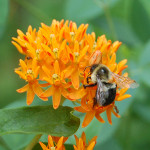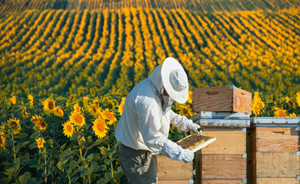Summary of “A Story about Fact Checking: Re Bees and Imidacloprid”
 The article, “USDA study concludes neonics not driving bee deaths-As White House set to announce ‘bee revival’ plan'” by Jon Entine was placed on a community list serve by a Master Gardener apparently in support of the neonicotinoid (aka: neonic) insecticide, Imidacloprid. When we at RCLA were asked to give an opinion on the article, it raised red flags due to the presence of several sweeping statements indicating Imidacloprid to be harmless for honeybees. Entine credited these findings to research published in (as he calls it) “PLOS ONE” but no reference was given. The Entine statements contradicted information in the scientific publication, “Assessment of Chronic Effects of Imidacloprid on Honey Bee Colony Health,” by Dively, et al. published in PLoS ONE, with a publication date 5 days prior to the Entine article’s date. In contrast to the Entine article’s claim of no problem at any Imidacloprid dose level; the Dively, et al. publication found that Imidacloprid was associated with increased parasite numbers at all exposure levels and significant adverse effects to honey bees at the two upper level doses (see text below for details).
The article, “USDA study concludes neonics not driving bee deaths-As White House set to announce ‘bee revival’ plan'” by Jon Entine was placed on a community list serve by a Master Gardener apparently in support of the neonicotinoid (aka: neonic) insecticide, Imidacloprid. When we at RCLA were asked to give an opinion on the article, it raised red flags due to the presence of several sweeping statements indicating Imidacloprid to be harmless for honeybees. Entine credited these findings to research published in (as he calls it) “PLOS ONE” but no reference was given. The Entine statements contradicted information in the scientific publication, “Assessment of Chronic Effects of Imidacloprid on Honey Bee Colony Health,” by Dively, et al. published in PLoS ONE, with a publication date 5 days prior to the Entine article’s date. In contrast to the Entine article’s claim of no problem at any Imidacloprid dose level; the Dively, et al. publication found that Imidacloprid was associated with increased parasite numbers at all exposure levels and significant adverse effects to honey bees at the two upper level doses (see text below for details).
The most generous explanation for this significant discrepancy between the Dively, et al. and Entine articles is that Mr. Entine did not carefully read Dively, et al.’s scientific report, assuming it was the “PLOS ONE” article which he indicated as his source.
Whatever the reason for this apparent misrepresentation, Entine’s article might very well give list serve readers the impression that based on recent scientific findings, for honeybees neonics are not a hazard and that Imidacloprid can be used around them even at high levels without the risk of potential problems. This would be wrong as the fact checking by RCLA discovered and as is explained below.
A Story about Fact Checking: Re Bees and Imidacloprid
 Jon Entine’s failure to fully quote from a scientific publication that he inadequately referenced led him to draw erroneous deductions about bees and Imidacloprid in his March 2015 article (“USDA study concludes neonics not driving bee deaths-As White House set to announce ‘bee revival’ plan'”). Fact checking by RCLA revealed significantly different findings and conclusions than those stated in Entine’s article.
Jon Entine’s failure to fully quote from a scientific publication that he inadequately referenced led him to draw erroneous deductions about bees and Imidacloprid in his March 2015 article (“USDA study concludes neonics not driving bee deaths-As White House set to announce ‘bee revival’ plan'”). Fact checking by RCLA revealed significantly different findings and conclusions than those stated in Entine’s article.
RCLA’s involvement began with inquiries from the public about an article sent through a list serve to a local Maryland community. The article, “USDA study concludes neonicsi not driving bee deaths-As White House set to announce ‘bee revival’ plan'” is from The Genetic Literacy Project’s director, Jon Entine.
RCLA looked into this matter and what we found is explained below:
In his article, Entine referred to a study from “independent researchers,” published in “PLOS ONE” (sic) but he failed to give the title, authors or date of publication for it.
A check of the literature and consultation with researchers led us to a USDA-supported publication, “Assessment of Chronic Effects of Imidacloprid on Honey Bee Colony Health,” by Dively, et al., published in PLoS ONE, on March 18, 2015. It appeared 5 days prior to the date on the Entine article.
The Dively, et al., paper contained a sentence very similar to one in the Entine article. However, Entine’s omission of a key qualifying word, and other pertinent facts, changed the statement’s meaning, and permitted conclusions to be conveyed that differed significantly from those reached by Dively et al.
An examination below of comparable statements from the Entine and Dively et al. articles shows why fact checking is important:
The Entine article includes the statement: “Even at the highest dose of pesticide exposure, the researchers found no difference in the performance of the treated and untreated hives. They found no evidence that Imidacloprid affected foraging activity during and after exposure in their experiments.”
The Dively et al. article included an important qualification – not mentioned by Entine: “Imidacloprid exposure doses up to 100 microgram/kg had no significant effects on foraging activity or other colony performance indicators during and shortly after exposure.” (italics added)
Dively, et al. went on to describe imidacloprid’s adverse effects as being delayed until “…later in the summer when colonies exposed to 20 and 100 microgram/kg [doses] experienced higher rates of queen failure and broodless periods which led to weaker colonies going into the winter.” Dively et al., then concluded that, “exposure to Imidacloprid at the higher range of field doses (20 to 100 micrograms/kg in pollen)…could cause negative impacts on honey bee colony health and reduced overwintering success…”
The Dively et al. publication also listed higher infestations of Varroa mites, (a significant bee pest) in all Imidacloprid-exposed colonies (Dively, G., et al., of “Assessment of Chronic Effects of Imidacloprid on Honey Bee Colony Health,” PLoS ONE, March 18, 2015).
The Entine article indicated there were no adverse effects on honey bees after exposure to Imidacloprid at any dose level. The Dively et al. article reported that there was no adverse effect during or shortly after exposure, but that there were significant, delayed, adverse effects in the honey bees exposed to the two higher dose levels of imidicloprid. Note, these higher dose levels are within the range of those used under actual field conditions. Dively, et al.’s findings are consistent with the scientific reports referenced in our previous publication “Monarchs, Milkweed, Flowering Plants, GMOs, Pesticides and People.”
As Rachel Carson advised, checking with primary sources should occur wherever possible. RCLA was pleased to act as a fact checking resource for list serve readers in this case. We regret that our clarification took place after the article had been sent and not before.
Note: Our attempt to confirm with Mr. Entine the source of his information about the Imidacloprid study described in his March 23, 2015 article, prior to preparing this piece were unsuccessful.
Dr. Diana Post and Munro Meyersburg
Rachel Carson Landmark Alliance
June 19, 2015
i The word “neonic” (pronounced neo-nic) is an abbreviated form of “neonicotinoid” a class of chemical insecticides.



